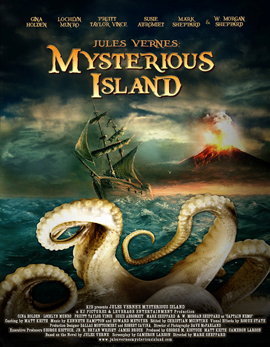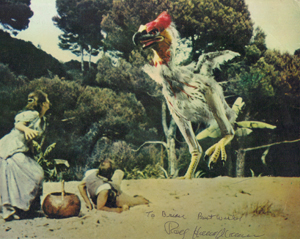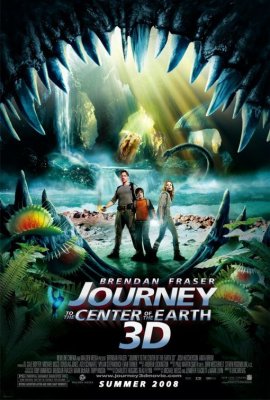A note to new readers…
If you have seen the movie adaptation of JOURNEY TO THE CENTER OF THE EARTH (3-D)
starring Brendan Fraser, or its sequel JOURNEY 2: THE MYSTERIOUS ISLAND (3-D) starring
Dwayne “The Rock” Johnson, the North American Jules Verne Society naturally
recommends you try reading the books that inspired them.
If you are over 10 years old, we believe you are ready for the book as Jules Verne
wrote it. He intended his writing to be read by all ages. JOURNEY TO THE CENTER
OF THE EARTH has been one of the most popular books ever written for over the last
140 years, since it was first published in 1864.
And there have been many adaptations of this tale made for the movies and television,
one of our members, Brian Taves has written a comphrehensive article on the various versions.
Jules Verne’s classic novel, The Mysterious Island, first published
in 1874, is best remembered not so much as a castaway saga, but as the story that
the drew the adventures of Captain Nemo to a close. In The Mysterious Island,
Verne explains that Nemo was born an Indian prince, who joined the rebellion of
1857 against the British rule of his homeland. His family killed, he fled with a
few loyal followers to the seas, building his fabulous submarine, the Nautilus.
He then begins to take revenge against British warships at sea, as told in Twenty
Thousand Leagues Under the Seas.
In early 2012, two new versions of The Mysterious Island have appeared
on screen, one in movie theaters, the other on the Syfy Channel. In particular,
Journey 2: The Mysterious Island, an enjoyable sequel to Journey to the
Center of the Earth 3-D (2008), incorporates elements of several Verne
stories, not only Twenty Thousand Leagues Under the Seas and The Mysterious
Island, and a bit of The Golden Volcano, first published in English
in 2008.
The Mysterious Island, and Twenty Thousand Leagues Under the Seas,
were first brought to the movie screen in a 1916 silent epic, actually the first
fiction film partly shot under the sea. Dozens of other versions of both novels
have appeared around the world since, including many pastiches continuing the voyages
of Captain Nemo.
A major recent discovery, however, changes the way we know The Mysterious Island.
In fact, it was a novel Verne had been working on for a decade, an epic entitled
Shipwrecked Family: Marooned with Uncle Robinson. However,
this version was rejected by Verne’s French publisher. He demanded it be entirely
rewritten, starting from scratch. That new novel is the classic known as The Mysterious
Island.
Only a few incidents are similar between the novels; and all the characters are
different. Shipwrecked Family told of a mother, father, and their young
children, whose ship is seized by pirates, and castaway on a small boat, with only
an avuncular old sailor to help them. By contrast, Mysterious Island begins
amidst the American Civil War, as prisoners escape in a balloon carried on a storm
to a Pacific island.
In Shipwrecked Family, like Mysterious Island, the castaways must learn
to survive with no resources outside of their own knowledge. Moreover, the flora
and fauna of the island do not match the hemisphere, and there it appears that some
of the animals have been used in scientific and biological experiments.
This was a theme added to the film adaptation of Mysterious Island in 1961
by Ray Harryhausen, and now that Shipwrecked Family has been published, it appears
Harryhausen was more in tune with Verne’s original ideas than could have been
guessed at the time. Exactly how Verne intended to complete Shipwrecked Family
remains unknown, due to his publisher’s intervention—and there is no
knowing if, as in Mysterious Island, Shipwrecked Family would
also have included the end of Captain Nemo. Given just how close we now know Verne
and Harryhausen were in their thinking, the North American Jules Verne Society dedicated
their publication of to the special effects master.
Shipwrecked Family is the second volume (of eight published to date) in
an ongoing series of first-time-ever Verne translations, edited by Brian Taves for
the Verne Society, and published by BearManor Media, and available on Amazon.com.
All the books are profusely illustrated with the original 19th century
engravings from Verne novels, and the cover is modified from one of the French first
editions. Supplementing the story is critical background, including two essays by
Verne about his enjoyment of “Robinson Crusoe” type stories. Expert
translation is provided by Sidney Kravitz, also translator of the definitive modern
edition of The Mysterious Island (Wesleyan University Press, 2002).
Of the Verne Society’s series, Michael Dirda of the Washington Post praised
the first volume, commenting:
“I am a Jules Verne reader and collector. As such, I deeply appreciate the new editions of Verne being published by BearManor Fiction in its Palik Series. The most recent volume The Marriage of a Marquis features a wealth of extras, starting with essays by three of the leading Verne scholars of our time: Brian Taves, the late Walter James Miller, and Jean-Michel Margot, followed by commentary by translator Edward Baxter and an additional Verne fragment translated by Kieran M. O’Driscoll. The paperback’s gorgeous cover resembles one of the classic French Hetzel editions. Jules Verne was more than just a writer of boys’ adventures and his oeuvre extends way beyond the four or five classics that everyone knows about. He’s a writer well worth exploring and rediscovering.”
Follow news of the series on our Facebook page “Jules Verne - The Palik Series,” while more information about the volumes currently available are found here.

 A biological experiment seen in the 1961 edition of Mysterious Island:
A biological experiment seen in the 1961 edition of Mysterious Island:
Beware of a bogus translation! For example Jules Verne’s novel Journey to
the Center of the Earth, written and published in French in 1864 (a somewhat
expanded, definitive edition appeared in 1867), was first translated into English
in 1871 and published in London. The identity of the translator is not known, but
the quality of the work was poor in every way. It changed the names and nationalities
of Verne’s characters (Lidenbrock became Hardwigg, Axel became Harry, etc.),
it “dumbed down” the story by chopping out most of the science, and
it added melodramatic episodes to the plot that did not exist in the original. Compare,
for example, the opening sentence of Verne’s original text with this translation
to see how the latter differs dramatically from what Verne actually wrote:
(original)
On 24 May 1863, which was a Sunday, my uncle, Professor Lidenbrock, came rushing back towards his little house, No. 19 Knigstrasse, one of the oldest streets in the old quarter of Hamburg.
(1871 “Hardwigg” translation)
Looking back to all that has occurred to me since that eventful day, I am scarcely able to believe in the reality of my adventures. They were truly so wonderful that even now I am bewildered when I think of them.
It is unfortunate that this inferior translation, because it happened to be the
first one published in English, went on to become the “standard” English
version of Verne’s novel and is still reprinted today by undiscerning British
and American paperback publishers such as Signet and Tor. Much more accurate English
translations of Verne’s Journey to the Center of the Earth include
the following (all available in modern paperback editions): an 1876 version originally
published by Routledge and reprinted by Bantam in 2006 (with an excellent introduction
by Kim Stanley Robinson), an 1877 translation by Frederick Amadeus Malleson reprinted
in 2005 in the “Barnes and Noble Classics” series, a fine 1965 translation
by Robert Baldick published by Penguin Books and frequently reprinted since then,
and a top-notch 1992 critical edition translated and edited by William Butcher in
the Oxford “World’s Classics” series.
— Professor Arthur B. Evans of DePauw University, author of numerous articles
on Verne and the award-winning Jules Verne Rediscovered (Greenwood, 1988).
Jules Verne (1828-1905) has been one of the world’s best-selling authors,
translated in over a hundred languages. He has been beloved now for over a century
for his imagination and story-telling skill.
One thing about Verne you need to know. As a Frenchman who wrote in his native language,
many of his stories were badly translated into English back in his own day. These
versions continue to be reprinted. Further, many of these books are abridged. If
you read one, you are not getting the full story (often 1/4 will be left out!).
This is explained by New York University Professor Walter James Miller, a Verne
translator and scholar honored by our Society.
 © 1993 - 2026 North American Jules Verne Society, Inc. — a 501(c)(3) Corporation
© 1993 - 2026 North American Jules Verne Society, Inc. — a 501(c)(3) Corporation

